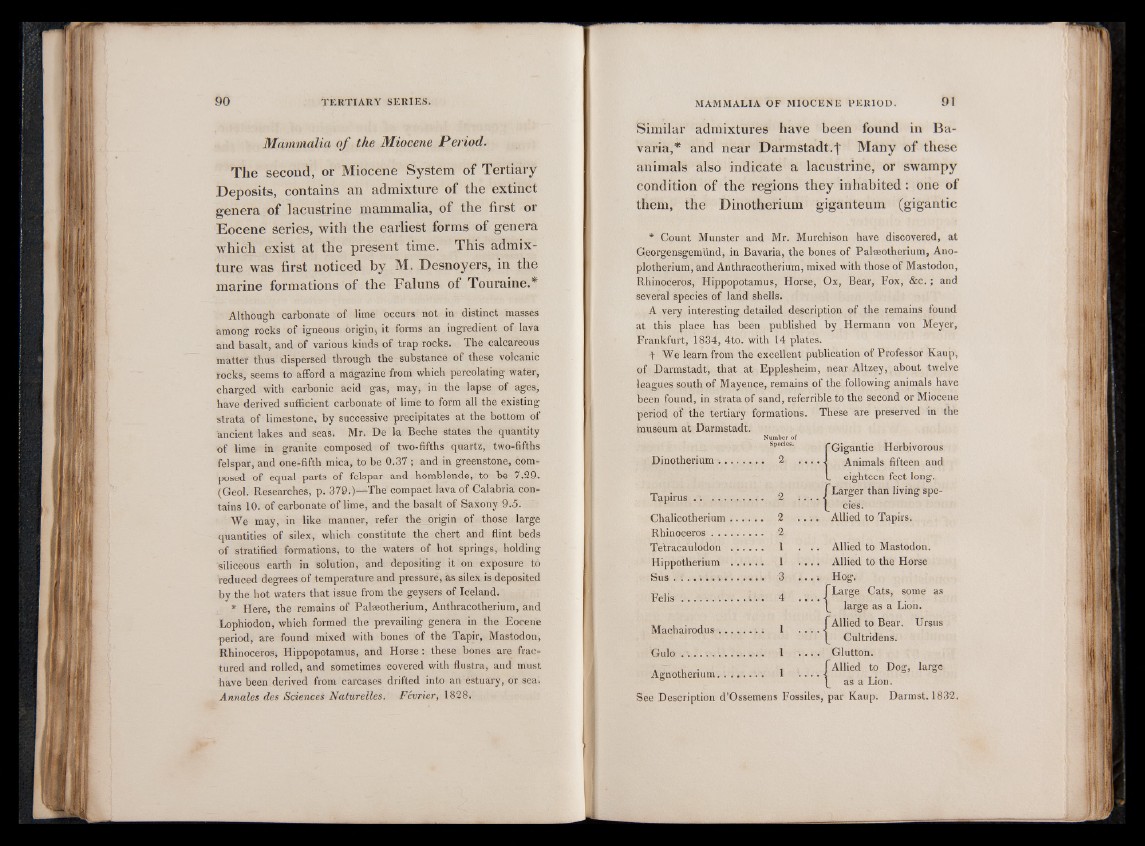
Mammalia o f the Miocene Period.
The second, or Miocene System of Tertiary
Deposits, contains an admixture of the extinct
genera of lacustrine mammalia, of the first or
Eocene series, with the earliest forms of genera
which exist at the present time. This admixture
was first noticed by M. Desnoyers, in the
marine formations of the Faluns of Touraine.*
Although carbonate of lime occurs not in distinct masses
among rocks of igneous origin, it forms an ingredient of lava
and basalt, and of various kinds of trap rocks. The calcareous
matter thus dispersed through the substance of these volcanic
rocks, seems to afford a magazine from which percolating water,
charged with carbonic acid gas, may, in the lapse of ages,
have derived sufficient carbonate of lime to form all the existing
strata of limestone, by successive precipitates at the bottom of
ancient lakes and seas. Mr. De la Beche states the quantity
of lime in granite composed of two-fifths quartz, two-fifths
felspar, and one-fifth mica, to be 0.37 ; and in greenstone, composed
of equal parts of felspar and hornblende, to be 7.29.
(Geol. Researches, p. 379.)—The compact lava of Calabria contains
10. of carbonate of lime, and the basalt of Saxony 9.5.
We may, in like manner, refer the origin of those large
quantities of silex, which constitute the chert and flint beds
of stratified formations, to the waters of hot springs, holding
siliceous earth in solution, and depositing it on exposure to
reduced degrees of temperature and pressure, as silex is deposited
by the hot waters that issue from the geysers of Iceland.
* Here, the remains of Palæotherium, Anthracotherium, and
Lophiodon, which formed the prevailing genera in the Eocene
period, are found mixed with bones of the Tapir, Mastodon,
Rhinoceros, Hippopotamus, and Horse : these bones are fractured
and rolled, and sometimes covered with flustra, and must
have been derived from carcases drifted into an estuary, or sea.
Annales des Sciences Naturelles. Février, 1828.
Similar admixtures have been found in Bavaria,*
and near Darmstadt.| Many of these
animals also indicate a lacustrine, or swampy
condition of the regions they inhabited : one of
them, the Dinothérium giganteum (gigantic
* Count Munster and Mr. Murchison have discovered, at
Georgensgemvind, in Bavaria, the bones of Paleeotherium, Ano-
plotherium, and Anthracotherium, mixed with those of Mastodon,
Rhinoceros, Hippopotamus, Horse, Ox, Bear, Fox, & c .; and
several species of land shells.
A very interesting detailed description of the remains found
at this place has been published by Hermann von Meyer,
Frankfurt, 1834, 4to. with 14 plates.
4 We learn from the excellent publication of Professor Kaup,
of Darmstadt, that at Epplesheim, near Altzey, about twelve
leagues south of Mayence, remains of the following animals have
been found, in strata of sand, referrible to the second or Miocene
period of the tertiary formations. These are preserved in the
museum at Darmstadt.
Number of
Species. "Gigantic Herbivorous
Dinothérium . . . . . . . 2 . . . . ] Animals fifteen and
_ eighteen feet long.
Tapirus................... . . . ,
Larger than living species.
Chalicotherium . . . . . 2 ___ Allied to Tapirs.
Rhinoceros............ . . . 2
Tetracaulodon . . . . . 1 . . . Allied to Mastodon.
Hippotherium . . . . . 1 ______ Allied to the Horse
Sus . . . . . . . . . . . Hog.
Felis ..................... Large Cats, some as
large as a Lion.
Machairodus . . . . . . . i . . . . ]
Allied to Bear. Ursus
Cultridens.
Gulo ...................... . . . l ______ Glutton.
Agnotherium. . . . . . . ,
Allied to Dog, large
as a Lion.
See Description d’Ossemens Fossiles, par Kaup. Darmst. 1832.